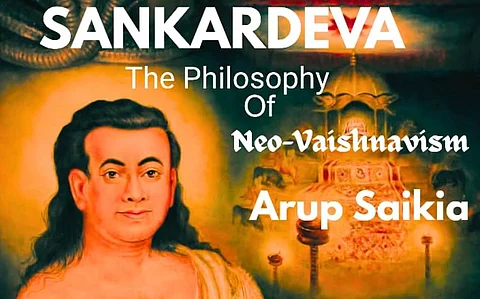
- Home
- Live Blog
- Breaking News
- Top Headlines
- Cities
- NE News
- Sentinel Media
- Sports
- Education
- Jobs

Samiran Bhuyan
(samiranbhuyan977@gmail.com)
Book Review
Noted writer and international Bhaona artiste Arup Saikia wrote and published a scholarly book, namely, “Sankardeva, The Philosophy of Neo-Vaishnavism,” in English. The socio-religious views of Sankardeva are uniquely highlighted in the book.
Unlike other books of social reformers, the aim and objectives of Sankardeva are different. He has nurtured religion and philosophy on an inclusive journey to advance human civilisation in the world with love and brotherhood. The culture is nothing but morality-orientated thinking or expression. This is the main philosophy of Neo-Vaishnavism. Vaishnavism existed beforehand. But Neo-Vaishnavism is research work in the Assamese perspective. The present Assamese community is based on the ideals of the great sage who awakened the thoughts and consciousness.
RELIGIOUS RECONSTRUCTION Writer Arup Saikia clearly depicts in the book the reality and outlook of Sankardeva. The book “Sankardeva, The Philosophy of Neo-Vaishnavism” is today serving the people with the thought of God in an environment surrounded by millions of devotees created by Sankardeva. So, Sankardeva became an institution run by consciousness. It inspires every generation with the ideals of St. Sankardeva.
The slightest human limitation of Sankardeva can’t be a barrier to the achievement of mountainous success. Some of his rumoured supernatural deeds overcome his limitations among the common masses. Sankardeva spent his entire life struggling against immorality and inequality and introduced the religion of heaven. The Vaishnavite priests are carrying it forward. The goal and objectives of Sankardeva are world civilisation and human welfare. But the rustic situation of Assam won’t create a congenial environment to demonstrate anything sans religion. Because the religion or superstition has existed since birth. So Sankardeva or Madhavdeva painted all theories with divine colour. They have accepted all incarnations of Lord Krishna. The direct worshipping of Krishna is the path of this religion. They openheartedly recognised the significance of Hindu religious books like the Mahabharata, Ramayana, Bhagawat, Veda, etc. They are bound to follow the customs, food habits, and ceremonies of Hinduism. Sankardeva hasn’t the slightest negligence or ill will towards these. The characteristics of Mahatma Gandhi are like that in some circumstances. During the Indian independence movement, Gandhiji embraced everyone but always kept the Bhagawat Geeta inone hand. The nature and demeanour of Mahatma Gandhi are of a Hindu revivalist. Likewise, Sankardeva is also a refined Hindu revivalist.
SUMMARY: Author and Bhaona artiste Arup Saikia’s analytical insights into the religious principles of Sankardeva have a base of logical reasoning. What we are seeing apparently may not be true. Religious beliefs are always abstract in a sense. It’s of a non-tangible nature. The point of the arrow can be directed any direction in open space. The literal explanations of rituals are imaginary and impractical. There’s a lot of scope for utilities. This is religion in another attire. Arup Saikia said, “Sankardeva is an efficient diplomat, although he is seen as a religious preacher.” Why did Sankardeva act like this? Sankardeva would not have succeeded in any revolutionary reformation in the Assamese milieu without religion. The casteless society is a product of an open competitive market. The people of Assam haven’t heard about open economy. Even feudalism did not grow properly. As regards the commercial restrictions or backwardness, the social environment was very challenging to practice social equality. Writer Arup Saikia very minutely describes the various techniques Sankardeva incorporates to attain the goal of humanity. Besides “Sankardeva, The Philosophy of Neo-Vaishnavism”, Arup Saikia has enriched Assamese history and culture through his many valuable books already published, namely Bhaona Unmesh, Bhoroli To Volga,” “Bhaona and Assamese Society,” “Sankardeva Ejon Samaj Vigyani,” the poetry books “Sabda” and “Silpi Satta,” etc. The total number of pages of the book is one hundred eighty only, and it is published by Prajanmya Unmesh under the aegis of Sankardeva Society. The ISBN number of the book is 978-93-343-4658-9.
(Samiran Bhuyan is a writer, cultural activist, and motivational speaker.)